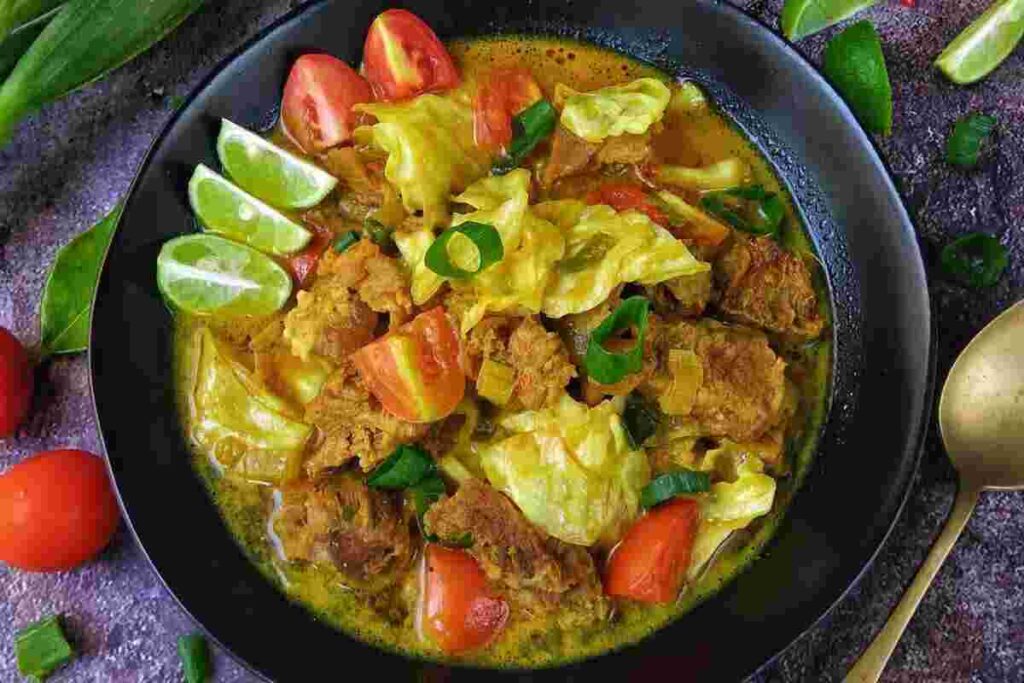Tongseng is a beloved Indonesian dish known for its rich, aromatic broth and tender, braised meat infused with an array of traditional spices. Originating from Central Java, this dish has gained widespread popularity across the country and beyond. Often compared to gulai (Indonesian curry), Tongseng stands out due to its use of kecap manis (sweet soy sauce) and fresh vegetables, creating a balance of savory, sweet, and spicy flavors.
Whether you are a seasoned culinary expert or an adventurous food enthusiast, understanding the origins, ingredients, and cooking techniques of Tongseng can elevate your appreciation for Indonesian cuisine.
The Origins and Cultural Significance of Tongseng
Tongseng is believed to have originated in the late 19th or early 20th century in the regions of Solo and Yogyakarta. It was traditionally made by goat and lamb traders who used leftover meat and bones to create a flavorful stew. Over time, the dish evolved with the addition of kecap manis, cabbage, tomatoes, and chili, making it a staple in Indonesian warungs (small eateries) and home kitchens.
The dish is often associated with festive occasions and family gatherings, especially during Eid al-Adha when goat meat is widely available. Today, Tongseng is commonly found in street food stalls and upscale restaurants, offering variations that cater to different preferences and dietary needs.
Key Ingredients in Tongseng
To achieve the authentic flavors of Tongseng, selecting the right ingredients is essential. Here are the core components that define this dish:
Meat Selection
- Traditionally, goat meat is used for its distinct flavor and texture. However, lamb, beef, and even chicken are popular alternatives.
- The meat is typically cut into small chunks and braised to achieve tenderness.
Spices and Aromatics
Shallots and Garlic: Provide a fragrant base for the dish.
Galangal and Ginger: Add warmth and depth of flavor.
Lemongrass and Bay Leaves: Infuse the broth with citrusy and herbal notes.
Coriander, Cumin, and Turmeric: Enhance the complexity of the dish with earthy and slightly peppery undertones.
Seasonings and Condiments
Kecap Manis (Sweet Soy Sauce): Balances the savory flavors with a touch of sweetness.
Tamarind Paste: Adds a subtle tangy contrast.
Chili Peppers: Adjusted to taste for varying levels of heat.
Coconut Milk: Optional but often included to create a richer broth.
Vegetables and Garnishes
Cabbage and Tomatoes: Provide texture and freshness to the dish.
Green Onions and Fried Shallots: Used as a garnish for added aroma and crunch.
Step-by-Step Guide to Cooking Tongseng
Preparing Tongseng at home requires careful attention to detail. Below is a simple yet effective method to create an authentic version:
Step 1: Prepare the Meat
- Cut the meat into bite-sized pieces.
- In a pot, bring water to a boil and blanch the meat briefly to remove impurities.
- Drain and set aside.
Step 2: Sauté the Spices
- In a wok or deep pan, heat cooking oil over medium heat.
- Add shallots, garlic, galangal, ginger, lemongrass, bay leaves, coriander, cumin, and turmeric.
- Stir-fry until aromatic.
Step 3: Braise the Meat
- Add the meat to the spice mixture and stir until coated.
- Pour in water or broth, then cover and simmer for 45-60 minutes until the meat is tender.
Step 4: Add Seasonings and Vegetables
- Stir in kecap manis, tamarind paste, and chili peppers.
- Add chopped cabbage and tomatoes.
- Let simmer for another 10-15 minutes to blend flavors.
Step 5: Final Touches
- Modify the seasoning with salt and pepper as desired.
- Garnish with green onions and fried shallots before serving.
- erve warm with steamed rice for a satisfying meal.
Variations of Tongseng
While the traditional recipe uses goat meat, there are several variations of Tongseng that cater to different tastes and dietary preferences:
Tongseng Sapi (Beef Tongseng): Uses beef as an alternative to goat meat for a milder flavor.
Tongseng Ayam (Chicken Tongseng): A lighter, quicker-to-cook version that is just as flavorful.
Tongseng Tanpa Santan (Tongseng Without Coconut Milk): A healthier variation that maintains the dish’s essence without the richness of coconut milk.
Where to Enjoy Authentic Tongseng
For those traveling in Indonesia, Tongseng can be found in various settings:
Street Vendors and Warungs: Small roadside eateries in Central Java, Yogyakarta, and Jakarta offer some of the best authentic Tongseng.
Traditional Markets: Vendors in local markets prepare fresh Tongseng daily.
Upscale Indonesian Restaurants: High-end dining establishments have refined versions of Tongseng with premium cuts of meat and gourmet presentations.
Conclusion
Tongseng is more than just a dish—it is a celebration of Indonesia’s rich culinary heritage. Whether you prepare it at home or seek it out in a local warung, the dish offers a deep, satisfying experience with every spoonful. By understanding the ingredients, cooking techniques, and variations, you can appreciate and even master the art of making Tongseng, bringing a taste of Indonesia’s vibrant flavors to your table.
Nasi Box Jakarta: For food enthusiasts and culinary professionals, experimenting with Tongseng’s spice blend and pairing it with different meats or side dishes can open new doors to creativity in the kitchen. So why not try making Tongseng today and immerse yourself in the flavors of Indonesia?



